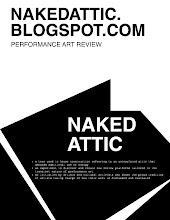TALK SHOW, Omer Fast, Abrons Art Center. November 11, 2009.
Two middle age men stepped onto the stage; they both looked familiar to me.
“So how did you get into this mess?” one man asked.
The other man proceeded to answer this question. He spoke about life in the 60’s, how teaching led him to political activism, and how Kennedy and Martin Luther King's deaths turned him toward violent measures. He reminisced about falling in love and burst into protest songs twice. The man spoke passionately, nervously and yet seemed a bit rehearsed. He ended his story by describing the accidental explosion at 11th street that killed his girlfriend and collaborator “Diane.”
This was when I realized that the person speaking was Bill Ayers from Weather Underground, and as in most of his interviews about the Underground, he made it clear that while Diane's death changed his entire approach, it also made him more determined to be an activist for the peace movement.
Applause.
Ayers exited the stage, and Lili Taylor took his seat. She asked the man on stage, whom I later found out was actor Tom Noonan, “So how did you get into this mess?” The game of telephone began.
And it was broken right the way. The actor had left out most of the idiosyncratic details in Ayers' narrative. His lifelong ideological struggle quickly evaporated into a tall tale about how loving a young woman led him to violent and regretful political actions. This left very little for Lili to work with. She basically had to start from a fairly generic love story and spin it out into a performance removed from historical context. Despite all, she did manage to captivate the audience with the tone and emotion of her performance.
Four more performers took turns. While I never thought a work by Omer Fast would make me laugh out loud, I was grateful that comedian Dave Hill took charge of the few rather grim narratives and injected some comic relief. By the time we got to the last performer, Rosie Perez, Diane had become a dangerously beautiful queer activist killed in an anti-Iraq-war protest because the protesters were making bombs to one-up each other in a competition for attention.
It was hard to watch Bill Ayers’ story deteriorating into farce with him sitting in the front row. But what did we expect? The performance was meant to be a kind of high-end theatrical experiment. And yet I couldn’t help but compare it to Fast’s other video works, particularly Godville (2005.) My dissatisfaction with the theater piece led me to explore how different performative structures produce and alter meaning, and how the role of forgetting plays out in the artist’s work.
In Talk Show, forgetting is a part of the act, a form of omission based on improvisation and the pressure of telling a story in real time. When something is left out by a player early in the chain, every subsequent player has to construct the narrative without that information.
In Godville, forgetting is the subject matter. The impression of a hole in the narrative is created through repeating and layering multiple interpretations, using jump cuts to compress time. The more we see, the less we feel we know about the actual narrative. In contrast, in the theater version where time is linear, the dissonance comes from the fact that we know more than the performer.
I guess the act of forgetting is much messier in real life. Rather than a kind of metaphorical erosion that we tend to theorize and recreate, forgetting things can be abrupt and arbitrary as a game of telephone.
And how about Bill Ayers? I wonder how many times he has told his story at this point in his life, and how many edits he has gone through in order to present a version of a remembrance that might just be too significant to be broken apart.
-- Annie Shaw
.jpg)
No comments:
Post a Comment